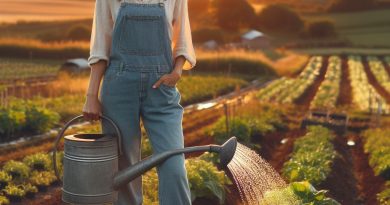Small Farm, Big Yield: Secrets Unveiled
Last Updated on March 4, 2024
Introduction
Agriculture thrives on the backbone of small farms.
These modest plots wield immense power in global food production.
They foster biodiversity, preserve traditional practices, and sustain local economies.
In this blog post, we delve into the hidden gems of small-scale farming.
We uncover the secrets that empower these seemingly diminutive operations to yield significant results.
Through innovative techniques and sustainable practices, small farms maximize productivity while minimizing environmental impact.
We explore the resilience and adaptability inherent in small-scale agriculture.
From crop diversification to rotational grazing, these farms exemplify efficiency and resourcefulness.
Moreover, they play a crucial role in food security, providing fresh produce and nourishment to communities.
This post sheds light on the often overlooked contributions of small farms to the agricultural landscape.
We highlight their potential to revolutionize modern farming practices.
Join us as we embark on a journey to unravel the mysteries behind small farms’ big yields.
Get ready to be inspired by their ingenuity and determination to feed the world.
Utilizing Vertical Farming Techniques
Definition and explanation of vertical farming
Vertical farming refers to a method of growing crops vertically, using stacked layers or vertical structures, instead of traditional horizontal farming practices.
This innovative technique maximizes space in limited areas, such as small farms or urban environments.
Vertical farming utilizes various technologies, including hydroponics, aeroponics, and aquaponics.
Hydroponics involves growing plants in nutrient-rich water, while aeroponics is a method of growing plants in an air or mist environment without soil.
Aquaponics combines aquaculture and hydroponics, creating a symbiotic relationship between fish and plants.
Benefits of vertical farming for small farms
- Maximizing space: Vertical farming enables small farms to optimize their land usage by growing crops in multiple layers, resulting in higher crop yields per square foot.
- Increased production: The controlled environment of vertical farming allows for year-round crop production, reducing the impact of seasonal fluctuations and ensuring a consistent supply.
- Water conservation: Vertical farming systems consume significantly less water compared to traditional farming. With hydroponics and aeroponics, water usage is minimized as plants receive nutrients directly instead of through soil.
- Pest control: Vertical farming reduces the risk of pests and diseases, as the enclosed environment makes it easier to control and prevent infestations. This reduces the need for harmful pesticides, promoting more sustainable farming practices.
- Energy efficiency: By utilizing LED lights and advanced climate control systems, vertical farming optimizes energy consumption, making it a more environmentally friendly approach.
Examples of successful vertical farming practices
- AeroFarms: Based in Newark, New Jersey, AeroFarms is a leading vertical farming company that grows a variety of leafy greens and herbs. Their indoor vertical farms produce crops without natural sunlight, using LED lights to provide the necessary light spectrum for plant growth.
- Plenty: Located in San Francisco, Plenty uses vertical farming to grow a wide range of produce, including leafy greens and strawberries. Their vertical farms are equipped with advanced robotics and artificial intelligence systems to monitor and optimize plant growth.
- Sky Greens: Hailing from Singapore, Sky Greens operates vertical farms that utilize rotating shelves. This technology maximizes sunlight exposure for each plant, resulting in higher crop yields and reduced energy consumption.
- Gotham Greens: With locations in New York City and Chicago, Gotham Greens combines both rooftop and vertical farming to grow high-quality greens. Their hydroponic systems not only minimize water usage but also prioritize sustainable practices and local food production.
- Farm.One: Based in Manhattan, Farm.One specializes in vertical farming of specialty herbs, microgreens, and edible flowers. Their vertical farms are located in controlled environments, allowing for precise control over temperature, humidity, and lighting.
In fact, vertical farming techniques offer numerous benefits for small farms, including space optimization, increased production, water conservation, pest control, and energy efficiency.
Successful examples of vertical farming practices, such as AeroFarms, Plenty, Sky Greens, Gotham Greens, and Farm.
One, demonstrate the effectiveness of this innovative approach in agriculture.
By embracing vertical farming, small farms can achieve big yields and contribute to a more sustainable and resilient food system.
Maximizing Space Efficiency
When it comes to small farms, space efficiency plays a crucial role in achieving a big yield.
By making the most out of the available area, farmers can maximize their productivity and profitability.
In this section, we will explore the importance of space efficiency and discuss effective techniques for small-scale cultivation.
Importance of Space Efficiency in Small Farms
- Optimizing space utilization allows small farms to grow a wide variety of crops and increase their overall yield.
- With limited land, it becomes essential to use every inch wisely, minimizing wastage and maximizing production.
- By efficiently organizing the available space, farmers can cultivate more crops, diversify their offerings, and meet market demands.
- Space efficiency also enables small farms to implement sustainable practices, reducing water consumption and optimizing nutrient usage.
- Moreover, a well-managed and visually appealing farm attracts customers, providing additional marketing opportunities.
Implementing Raised Beds and Containers for Cultivation
- Raised beds offer multiple benefits, including improved soil drainage, better aeration, and easier weed control.
- They allow farmers to plant crops closer together, maximizing space utilization and increasing the overall yield per area.
- Containers, such as pots or grow bags, are another efficient way to grow crops, especially in limited spaces.
- They are portable, can be placed on patios or rooftops, and allow for easier crop rotation and space management.
- By using raised beds and containers, small farmers can optimize their available space and grow a diverse range of crops.
Utilizing Trellises and Vertical Structures for Growing Crops
- Trellises and vertical structures provide excellent solutions for growing climbing plants and vine crops.
- They help maximize space by growing crops vertically, utilizing the upward growing nature of certain plants.
- Crops like tomatoes, cucumbers, and beans can be trained to grow upwards, freeing up ground space for other crops.
- Trellises also assist in better airflow and light penetration, reducing the risk of diseases and promoting healthy plant growth.
- With the use of trellises and vertical structures, small farms can significantly increase their crop production per square foot.
In short, space efficiency is vital for small farms to achieve big yields.
By implementing techniques like raised beds, containers, trellises, and vertical structures, farmers can optimize their available space and cultivate a diverse range of crops.
This not only increases productivity but also opens up marketing opportunities and facilitates sustainable practices.
Embracing space efficiency is the key to success for small farms in today’s competitive agricultural industry.
Read: From Conventional to Organic: A Farmer’s Path
Enhancing Soil Health and Fertility
Importance of soil health for high yield
- Healthy soil is vital for achieving high agricultural yield.
- Nutrient-rich soil supports the growth of healthy crops.
- Healthy soil enhances root development, leading to better water and nutrient uptake.
- It promotes beneficial soil microbial activity, improving nutrient availability for plants.
- Soil health also plays a crucial role in managing pests and diseases.
Incorporating organic matter and composting practices
- Adding organic matter to soil improves its fertility and structure.
- Organic matter releases nutrients slowly, providing a steady supply to plants.
- Composting kitchen scraps and yard waste create nutrient-rich compost for soil amendment.
- Compost enhances moisture retention, reducing irrigation needs.
- It also supports soil organisms, promoting a healthy soil ecosystem.
Implementing cover crops and crop rotation techniques
- Cover crops, such as legumes, help improve soil fertility.
- Legumes fix atmospheric nitrogen, enriching the soil without synthetic fertilizers.
- Cover crops also prevent erosion, suppress weeds, and improve soil structure.
- Crop rotation involves alternating the type of crops grown in a particular area.
- It prevents nutrient depletion and reduces the risk of pests and diseases.
- For example, rotating nitrogen-fixing legumes with heavy nitrogen-feeders can improve soil fertility.
- Crop rotation disrupts pest life cycles, reducing the need for chemical pesticides.
- It also allows farmers to break weed and disease cycles, reducing reliance on herbicides and fungicides.
- Additionally, different crops have varying nutrient requirements, preventing nutrient imbalances in the soil.
- Successful crop rotation plans integrate cover crops and cash crops strategically.
In essence, enhancing soil health and fertility is essential for achieving high yields on small farms.
Healthy soil with rich nutrient content supports robust plant growth and improves water and nutrient uptake.
Incorporating organic matter through composting practices helps improve soil fertility and structure.
It releases nutrients slowly and supports beneficial soil organisms.
Implementing cover crops and crop rotation techniques further enhances soil fertility, prevents erosion, and manages pests and diseases effectively.
By implementing these practices, small farmers can maximize their yield and maintain a sustainable and environmentally friendly farming system.
Read: Next-Gen Farmers: Shaping Agriculture’s Future
Adopting Precision Farming Technologies
Explanation of precision farming technologies
- Precision farming refers to the use of modern technology to optimize farming practices.
- It involves collecting data and analyzing it to make informed decisions about crop production.
- By using precision farming technologies, farmers can adjust their practices based on specific field conditions.
- This approach allows for targeted resource management and increased efficiency in farming operations.
Benefits of precision farming for small farms
- Increased crop yields: Precision farming techniques allow for accurate application of inputs, leading to higher yields.
- Cost savings: By optimizing resource use, small farmers can reduce waste and save money.
- Environmental sustainability: Precision farming helps minimize environmental impacts by reducing the use of fertilizers and pesticides.
- Improved crop quality: By monitoring and managing crop conditions closely, small farmers can enhance the quality of their produce.
- Reduced labor requirements: Automation and technology simplify tasks, reducing the need for manual labor on small farms.
Examples of precision farming tools and techniques
- Global Positioning System (GPS): GPS technology enables precise mapping and field analysis for targeted farming.
- Variable Rate Technology (VRT): VRT allows for adjusting input application rates based on varying field requirements.
- Data collection and analysis: By utilizing sensors and software, farmers can gather detailed information about soil and crop health.
- Remote sensing: Satellite imagery and drones provide real-time data on crop conditions, aiding decision-making.
- Automated machinery: Self-driving tractors and robotic systems can perform tasks with precision and efficiency.
- Predictive modeling: Advanced algorithms and weather data help farmers make informed predictions for better planning.
Precision farming technologies offer significant advantages for small farms, enabling them to compete in a rapidly changing agricultural sector.
By implementing these tools and techniques, small farmers can improve their productivity, reduce costs, and enhance environmental sustainability.
The ability to make data-driven decisions tailored to specific field conditions empowers small farmers to maximize their yields and optimize resource use.
Read: Vineyard Dreams: Sustainable Wine Making

Implementing Crop Rotation Strategies
A well-planned crop rotation strategy is essential for small farms to maintain soil fertility and maximize yield.
By alternately planting different crops in a specific sequence, farmers can improve soil health, manage pests, and increase overall productivity.
Importance of Crop Rotation in Maintaining Soil Fertility
Crop rotation is crucial for maintaining soil fertility because it helps prevent nutrient depletion and the buildup of pests and diseases.
Continuous cultivation of the same crop can deplete specific nutrients present in the soil, leading to lower yields over time.
By rotating crops, farmers ensure that different plant varieties extract different nutrients, allowing for a more balanced nutrient cycle.
Moreover, crop rotation disrupts the life cycles of pests and diseases that target specific crops.
It reduces the chances of cumulative buildup and helps break the cycle of pests and diseases by confounding their breeding and feeding patterns.
This, in turn, reduces the reliance on chemical inputs, making crop rotation environmentally friendly.
Explanation of Different Crop Rotation Methods
1. Sequential Crop Rotation
In sequential crop rotation, crops are grown in a specific order following a predetermined sequence.
This method allows for optimal utilization of available nutrients and reduces the risk of plant pathogens and pests that specialize in specific crops.
2. Intercropping
Intercropping involves growing two or more crops simultaneously in the same field, which can provide various benefits.
For instance, legumes can be intercropped with other crops to fix nitrogen in the soil, thus reducing the need for synthetic fertilizers.
Additionally, intercropping enhances biodiversity and promotes natural pest control.
3. Cover Cropping
Cover cropping involves growing crops specifically for the purpose of improving soil health.
These crops are typically planted during periods when the main cash crops are not cultivated.
Cover crops help prevent soil erosion, reduce weed growth, improve soil structure, and add organic matter back into the soil.
Advantages of Crop Rotation for Small Farms
Implementing crop rotation strategies offers numerous benefits for small farms, both economically and environmentally.
1. Increased Soil Fertility
Crop rotation enhances soil fertility by improving nutrient availability, maintaining a balanced nutrient cycle, and minimizing the need for synthetic fertilizers.
This leads to higher crop yields and reduced production costs for small farmers.
2. Pest and Disease Management
By disrupting the breeding and feeding patterns of pests and diseases, crop rotation effectively reduces the occurrence of outbreaks.
This reduces the reliance on chemical pesticides and promotes sustainable farming practices, ultimately benefiting both the environment and human health.
3. Weed Control
Crop rotation suppresses weed growth through diverse cultivation.
Different crops have varying growth patterns and root exudates, which can hinder the growth of specific weed species.
This reduces the need for chemical herbicides and reduces weed-related yield losses.
4. Enhanced Biodiversity
Crop rotation promotes biodiversity on farms by providing habitats for beneficial insects, birds, and microorganisms.
These organisms play essential roles in pollination, pest control, and soil health, contributing to a more sustainable farming ecosystem.
5. Risk Diversification
Planting a variety of crops through rotation helps mitigate risks associated with weather fluctuations, pests, and market demands.
If one crop fails, others may still thrive, ensuring a more stable income for small farmers.
In general, crop rotation is a vital practice for small farms.
By maintaining soil fertility, managing pests and diseases, and diversifying risks, crop rotation contributes to sustainable and profitable farming.
Implementing different crop rotation methods can unleash the potential of small farms, leading to big yields.
Read: Florida Citrus Grower Goes Green: A Tale
Utilizing Integrated Pest Management (IPM)
Definition and explanation of IPM
Integrated Pest Management (IPM) is an approach to pest control that focuses on using multiple strategies to minimize the use of pesticides.
It involves careful monitoring, identification, and prevention of pests, as well as the use of biological, cultural, and chemical control methods.
Benefits of IPM in maximizing crop yield
- Reduced pesticide usage: By implementing IPM, farmers can significantly reduce their reliance on chemical pesticides. This not only minimizes the risk of harmful effects on human health and the environment but also saves costs associated with purchasing these chemicals.
- Preservation of natural enemies: IPM encourages the preservation and promotion of beneficial organisms such as predators, parasites, and pollinators. These natural enemies help control pests and contribute to a more balanced ecosystem, ultimately resulting in higher crop yields.
- Resistance management: Frequent pesticide use can lead to the development of resistance in pests. By following IPM practices, farmers can rotate different pest control methods, making it more difficult for pests to develop resistance and ensuring better long-term pest management.
- Enhanced crop quality: IPM focuses on preventing pest damage, which helps maintain the quality of crops. Healthy plants are more resistant to diseases and have a higher nutritional value, making them more marketable and profitable for farmers.
Examples of IPM practices suitable for small farms
- Crop rotation: Rotating crops can disrupt pest life cycles, reducing the buildup of pests that specialize in a particular crop. Different crops may also have varying pest resistance, further enhancing pest control.
- Biological control: Introducing natural enemies, such as ladybugs, lacewings, or parasitic wasps, can help control pest populations. This method has minimal environmental impact and is particularly effective for small farms.
- Cultural practices: Practices like proper sanitation, weed management, and regular field monitoring can help prevent pest infestations. Removing crop residues and controlling weeds eliminate potential habitats and food sources for pests.
- Trap crops: Planting specific crops that pests prefer can lure them away from the main crop, protecting it from severe damage. The trap crop should be carefully managed to prevent the pests from spreading to the primary crop.
- Use of pheromone traps: Pheromones are chemicals produced by pests to communicate and attract mates. Pheromone traps use these chemicals to lure and trap pests, reducing their numbers and preventing mating and reproduction.
- Natural pesticides: In situations where pest populations become too large to manage using non-chemical methods alone, farmers can resort to the use of natural pesticides derived from plants or bacteria. These are generally less harmful to beneficial organisms and have a shorter residual effect.
By utilizing IPM practices, small farmers can achieve significant benefits, including higher crop yields, reduced pesticide use, and improved overall farm sustainability.
Implementing these strategies requires careful planning, monitoring, and a proactive approach to pest management.
It may require additional time and effort initially, but the long-term benefits to crop health, productivity, and the environment make IPM a worthwhile investment for small farms.
Harnessing the Power of Sustainable Farming
Importance of sustainability for small farms
- Sustainability is crucial for small farms as it ensures long-term viability and environmental protection.
- By adopting sustainable practices, small farmers can reduce costs, increase yields, and enhance soil fertility.
- Sustainable farming promotes biodiversity, conserves water resources, and mitigates the impact of climate change.
- It helps small farmers build resilient and self-sufficient systems that can withstand fluctuating market conditions.
- Sustainability also plays a vital role in preserving and enriching the rural landscape and cultural heritage.
Introduction to sustainable farming practices
- Sustainable farming focuses on minimizing synthetic inputs and instead emphasizes natural and organic methods.
- Crop rotation, cover cropping, and integrated pest management are essential practices in sustainable farming.
- Conservation tillage, which reduces soil disturbance, helps to prevent erosion and improve soil health.
- Composting and the use of animal manure as natural fertilizers are common in sustainable farming systems.
- Diversification of crops and livestock species encourages ecological balance and reduces dependence on single commodities.
Case studies of successful sustainable farming models
- In the Salatin model, Joel Salatin uses rotational grazing and holistic land management practices to regenerate soil.
- The microgreens enterprise, led by small-scale farmer Kate Hofman, demonstrates the profitability of sustainable niche markets.
- Masanobu Fukuoka’s natural farming method, focusing on minimal intervention and biodiversity, revolutionized Japanese agriculture.
- The permaculture design system, developed by Bill Mollison, combines ecological principles and sustainable farming techniques.
- The success of the Singing Frogs Farm, practicing no-till agriculture and soil-building techniques, highlights sustainable profitability.
In review, sustainability is of utmost importance for small farms as it ensures their long-term viability and environmental well-being.
Through the adoption of sustainable farming practices, small farmers can increase yields, reduce costs, and improve soil fertility.
By prioritizing natural and organic methods, diversifying crops and livestock, and using conservation techniques, farmers can contribute to biodiversity conservation and climate change mitigation.
Several successful case studies demonstrate the profitability and resilience of sustainable farming models.
The Salatin model, microgreens enterprise, natural farming, permaculture design system, and Singing Frogs Farm all highlight the benefits of sustainable practices.
By harnessing the power of sustainable farming, small farms can secure a prosperous future while preserving the environment and their cultural heritage.
Harvesting and Post-Harvest Handling Techniques
Importance of proper harvesting techniques
- Harvesting at the right time ensures optimal yield and quality of produce.
- Improper harvesting can lead to damage, loss of nutritional content, and decreased shelf life.
- Careful handling during harvest prevents bruising, infection, and other damage to crops.
- It is essential to follow proper harvesting techniques to maximize the profitability of small farms.
- Properly harvested crops have higher market value and are preferred by consumers.
Methods for post-harvest handling to minimize losses
- Quickly cooling harvested crops slows down the growth of bacteria and extends their shelf life.
- Proper packaging protects crops from physical damage, moisture loss, and contamination.
- Crops should be sorted and graded based on quality, size, and ripeness to meet market demands.
- Utilizing storage facilities like cold rooms, drying sheds, and warehouses contribute to minimizing losses.
- Regular monitoring of temperature, humidity, and ventilation in storage areas helps maintain crop quality.
Tips for maintaining quality during storage and transportation
- Proper cleaning and removing of field heat before storing crops prevents fungal growth.
- Regularly inspecting stored crops for signs of spoilage or pest infestation is crucial.
- Implementing a First-in, First-out (FIFO) system ensures older stocks are used or sold before new ones.
- Using appropriate transportation methods, such as refrigerated trucks, helps preserve crop freshness.
- Handling crops with care during transportation minimizes physical damage and preserves quality.
Harvesting and post-harvest handling techniques are essential for small farms to maximize their yield and profitability.
By following proper harvesting techniques, farmers can ensure the quality and market value of their crops.
Implementing methods for post-harvest handling, such as quick cooling, proper packaging, and sorting, helps minimize losses and extends the shelf life of the produce.
Additionally, taking necessary precautions during storage and transportation, such as regular inspection, maintaining appropriate temperature and humidity, and using suitable transportation methods, contributes to maintaining crop quality.
By prioritizing these techniques, small farmers can overcome challenges in the market and achieve big yields.
Conclusion
Recap of the key points discussed
In this section, we uncovered the secrets behind small farms achieving impressive yields.
We highlighted the importance of soil health, crop rotation, and diversification.
Additionally, we emphasized the significance of proper planning, irrigation methods, and pest control.
Inspiring small farmers to implement the secrets unveiled
By understanding these secrets, small farmers have the potential to transform their yields and increase their profitability.
With dedication and hard work, they can adapt these practices and witness remarkable results.
It’s time to embrace change and unlock the untapped potential of our small farms.
Closing thoughts and invitation for comments and feedback
In a nutshell, small farms can indeed achieve big yields by implementing the secrets we’ve revealed.
We encourage all farmers to take a proactive role in adopting these practices and sharing their experiences.
Your insights and feedback are valuable in further enhancing the productivity of our farming community.
Join the conversation and let’s build a brighter future together.
Feel free to leave your comments and suggestions below.
We look forward to hearing from you!


